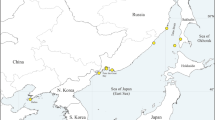Abstract
Rhabdopleura compacta Hincks is shown to be monoecious. It is suggested that the ovum is ovulated and extruded into the lumen of the coenecium via a temporary opening at the base of the metasome, and that the oviduct itself may serve only as a way for sperm to fertilise the ova internally. The zooids degenerate when reproducing sexually and when conditions are unfavourable. The larva and initial stages of astogeny are described. Some observations on seasonal variation in the colonies indicate that the dormant buds serve for storage of nutrients. Reproduction seems to occur throughout the year, but most actively in spring. Relationships with Cephalodiscus and the Bryozoa are briefly discussed.
Similar content being viewed by others
Literature cited
Allman, G. J.: On Rhabdopleura, a new form of Polyzoa, from deep-sea dredging in Shetland. Q. Jl microsc. Sci. 9, 57–63 (1869).
Andersson, K. A.: Eine Wiederentdeckung von Cephalodiscus (M. Intosh). Zool. Anz. 26, 368–369 (1903).
—: Die Pterobranchier der schwedischen Südpolar-Expedition 1901–1903. Wiss. Ergebn. schwed. Südpolarexped. 5, 1–122 (1907).
Braem, F.: Pterobranchier und Bryozoen. Zool. Anz. 38, 546–551 (1911).
Burdon-Jones, C.: The habitat and distribution of Rhabdopleura normani Allman. Univ. Bergen Årb. (Naturv. R.) 11, 1–17 (1954).
—: Hemichordata. In: Textbook of zoology, Vol. 2. pp 5–20. Ed. by T. J. Parker and W. A. Haswell, 7th ed. (Rev. by A. J. Marshall). London: Macmillan 1964.
Dawydoff, C.: Class des ptérobranches. In: Traité de zoologie, Vol. 11. pp 454–489. Ed. by P. Grassé. Paris: Masson 1948.
Fowler, G. H.: The morphology of Rhabdopleura normani Allm. In: Festschrift zum 70. Geburtstag R. Leukart, pp 293–297. Leipzig: Engelmann 1892.
Gilchrist, J. D. F.: Observations on the Cape Cephalodiscus (C. gilchristae, Ridewood) and some of its early stages. Ann. Mag. nat. Hist. (Ser. 8) 16, 233–243 (1915).
—: On the development of the Cape Cephalodiscus (C. gilchristae, Ridewood). Q. Jl microse. Sci. 62, 189–211 (1917).
Harmer, S. F.: The Pterobranchia of the Siboga Expedition. Siboga Exped. 26, 1–132 (1905).
John, C. C.: Cephalodiscus. ‘Discovery’ Rep. 3, 223–260 (1931).
Johnston, T. and N. Muirhead: Cephalodiscus. Br. Aust. N.Z. Antarct. Res. Exped. Rep. (Ser. B) 1 (3), 89–120 (1951).
Komai, T.: Internal structure of the pterobranch Atubaria heterolopha with an appendix on the homology of the ‘notochord’. Proc. Japan Acad. 25, 19–24 (1949).
Lankester, E. R.: A contribution to the knowledge of Rhabdopleura. Q. Jl microsc. Sci. 24, 622–647 (1884).
Masterman, A. T.: On the further anatomy and the budding processes of Cephalodiscus dodecalophus. Trans. R. Soc. Edinb. 19 (3), 507–527 (1898).
M'Intosh, W. C.: Preliminary notice of Cephalodiscus, a new type allied to Prof. Allman's Rhabdopleura, dredged in H. M. S. Challenger. Ann. Mag. nat. Hist. (Ser. 5) 10, 337–348 (1882).
Ridewood, W. G.: Pterobranchia: Cephalodiscus. ‘Discovery’ Rep. 2, 1–67 (1907).
—: Pterobranchia. Scient. Rep. Australas. Antarct. Exped. (Ser. C) 3 (2), 5–25 (1918a).
—: Cephalodiscus. Br. Antarct. Terra Nova Exped. 1910 (Zool.) 4, 11–82 (1918b).
Sato, T.: Vorläufige Mitteilung über Atubaria heterolopha gen. nov. sp. nov., einen in freiem Zustand aufgefundenen Pterobranchier aus dem Stillen Ozean. Zool. Anz. 115, 97–106 (1936).
Schepotieff, A.: Die Anatomie von Rhabdopleura. Zool. Jb. (Anat. Ont. Tiere) 23, 463–534 (1907a).
—: Knospungsprozeß und Gehäuse von Rhabdopleura. Zool. Jb. (Anat. Ont. Tiere) 24, 193–238 (1907b).
—: Knospungsprozeß von Cephalodiscus. Zool. Jb. (Anat. Ont. Tiere) 25, 405–494 (1908).
—: Die Pterobranchier des indischen Ozeans. Zool. Jb. (Syst. Ökol. Geogr. Tiere) 28, 429–448 (1909).
Stebbing, A. R. D.: Discovery of Rhabdopleura (Hemichordata) at Plymouth. Nature, Lond. 217, 1284 (1968).
—: The status and ecology of Rhabdopleura compacta Hincks (Hemichordata) from Plymouth. J. mar. biol. Ass. U.K. 50, 209–221 (1970).
Van der Horst, C. J.: Rhabdopleura. Bronn's Kl. Ordn. Tierreichs 4 (Abt. 4, Buch 2), 534–589 (1936).
Vaney, C. and A. Conte: Recherches sur le Rhabdopleura normani Allman. Revue suisse Zool. 14, 143–183 (1906).
Author information
Authors and Affiliations
Additional information
Communicated by J. E. Smith, Plymouth.
Rights and permissions
About this article
Cite this article
Stebbing, A.R.D. Aspects of the reproduction and life cycle of Rhabdopleura compacta (Hemichordata). Marine Biology 5, 205–212 (1970). https://doi.org/10.1007/BF00346908
Accepted:
Issue Date:
DOI: https://doi.org/10.1007/BF00346908




